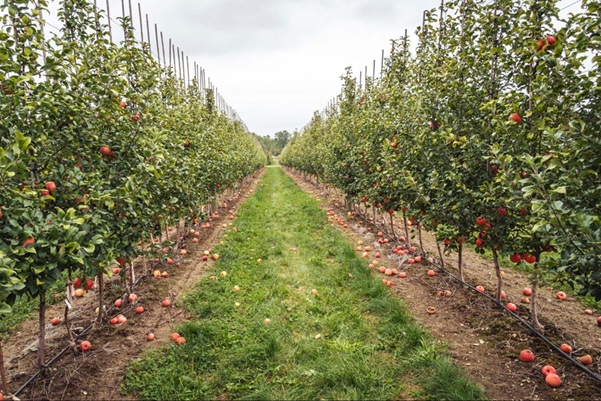An orchard is a delightful addition to any garden. It’s not only an aesthetically pleasing space but also a source of homegrown fruit, offering a satisfying harvest year after year. However, maintaining an orchard requires care, patience, and knowledge. If you’re looking to make the most of your orchard, these tips can help you streamline the process and keep your trees healthy and productive.
Prioritise Proper Planting
The foundation of a thriving orchard starts with proper planting. When you’re choosing where to plant your trees, ensure the site receives plenty of sunlight, as fruit trees need at least six to eight hours of sunlight each day to produce good yields.
The soil should be well-draining, as poor drainage can lead to root rot and other diseases. Before planting, consider testing the soil’s pH levels and improving it with organic matter if necessary. You should also pay attention to the garden design and the space between trees, as overcrowding can limit airflow and make it easier for diseases to spread.
Watering Wisely
Watering is a crucial part of orchard maintenance, but it’s essential to get it right. Trees need regular watering, especially in the warmer months, but overwatering can be just as harmful as underwatering. The key is to water deeply and less frequently, ensuring that the moisture reaches the root zone.
Drip irrigation is a great option, as it delivers water directly to the roots without wetting the foliage, which can encourage fungal diseases. Early morning is the best time for watering as it reduces evaporation and allows the tree to dry out before the evening.
Mulch for Moisture and Weed Control
Mulching is an easy yet highly effective way to keep your orchard in tip-top shape. It also adds nutrients to the soil as it breaks down over time. It’s generally an easy way to eliminate weeds and control moisture at the same time.
Make sure the mulch is spread evenly, but keep it away from the trunk to avoid moisture buildup, which can cause rot. Adding a fresh layer of mulch each year can make a noticeable difference in the health of your trees.
Pruning for Better Airflow and Shape
Pruning your fruit trees is an essential practice for maintaining both their health and productivity. Regular pruning encourages better airflow, which reduces the risk of fungal infections and ensures that sunlight can reach all parts of the tree. It also helps the tree focus its energy on producing fruit rather than growing too many branches.
When pruning, always remove dead, damaged, or crossing branches, and consider thinning the canopy to prevent overcrowding. Always use sharp, clean tools such as Hoseling loppers to avoid introducing pathogens into the cuts. The best time for pruning most fruit trees is during their dormant period in late winter or early spring.
Keep an Eye on Pests and Diseases
Like any garden, your orchard is susceptible to pests and diseases. To keep things under control, make regular checks for signs of trouble, such as discolouration, holes in the leaves, or unusual growth patterns. If you spot any issues early, you can often tackle them before they spread.
There are many organic pest control methods available, such as neem oil, insecticidal soap, and companion planting with pest-repellent herbs. Keep in mind that not all insects are harmful. Some, like bees and ladybugs, are vital for pollination and controlling other pests.
Support Tree Growth with Staking
In the early years of your orchard, young fruit trees may need a little extra help in the form of staking. Proper staking supports the tree as it establishes a strong root system, helping it grow straight and sturdy.
Be sure not to tie the tree too tightly to the stake, as this can cause damage. Use a soft material, like fabric ties, to secure the tree, and adjust them as it grows to prevent restriction. As the tree matures, you can remove the stake, allowing the tree to stand on its own. This process encourages the tree to develop stronger roots and a more robust structure.
Thin Fruit for Better Yields
It might seem counterintuitive, but thinning your fruit trees can actually increase your harvest. While it’s exciting to see your trees producing fruit, overcrowding can cause smaller, less healthy fruit and put unnecessary strain on the tree.
By selectively removing some of the fruit, you’re allowing the remaining ones to grow larger and sweeter. It also helps prevent branches from breaking under the weight of too much fruit. The best time to thin fruit is early in the growing season when the fruit is still small, and the tree can easily redirect its energy into the remaining fruit.
Use Companion Planting
Incorporating companion plants into your orchard is a simple and natural way to boost your trees’ health. Certain plants, such as lavender, marigolds, or garlic, can repel harmful pests, while others, like clover, improve soil fertility by fixing nitrogen.
These plants create a more balanced ecosystem within your orchard, attracting beneficial insects like bees, butterflies, and ladybugs that aid in pollination and pest control. By strategically placing these plants around your orchard, you can reduce the need for chemical pesticides and maintain a healthier, more sustainable growing environment.
Harvest at the Right Time
Harvesting your fruit at the right time is the final step in ensuring that your orchard is a success. Picking fruit too early can result in poor flavour and texture, while leaving it too late can cause overripe fruit to spoil. In other words, timing is key here.
Each type of fruit has its own ideal harvesting window, and it’s important to understand when your particular varieties are ready to be picked. A good indicator is the colour of the fruit, but it’s also worth checking for firmness and taste. Be gentle when harvesting to avoid damaging the fruit or the tree, and use proper tools, such as pruning shears, to clip fruit from the tree. After that, all that is left is to indulge in the sweet rewards of your hard work.
Conclusion
Maintaining an orchard is a rewarding and fulfilling endeavour. By following these simple yet effective tips, you can ensure that your trees stay healthy, productive, and beautiful throughout the seasons. Whether you’re just starting out or looking to refine your approach, these strategies will help you enjoy the fruits of your labour for many years to come.











